Blaenau Ffestiniog is a slate mining town in the ancient county of Merionethshire. The town is a popular tourist destination, with such attractions as the Ffestiniog Railway and the Llechwedd Slate Caverns. The town itself is relatively modern, being created to house the many thousands of people who came to the area to work in the slate mines, of which there were many. The largest of these mines was Oakeley Quarry, at one time the largest underground slate mine in the world. Over the years many of these smaller companies were taken over by Oakeley. During the Great War, many employees of the Oakeley Slate Quarry went off to war. Some 24 of these men lost their lives as a direct result of the conflict, and are commemorated on the Oakeley Slate Quarries War Memorial, which is situated in a memorial garden which is situated adjacent to the A470 road near Rhiwbryfdir.
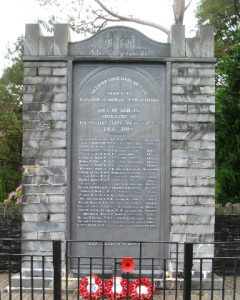
The Great War, 1914-1918
Richard Davies, Private, 290368, Royal Welsh Fusiliers. Richard was the son of David and Jane Davies, of Bron Barlwyd, Tanygrisiau, Blaenau Ffestiniog. He enlisted into the 7th Battalion, Royal Welsh Fusiliers at Blaenau Ffestiniog on 27 April 1908 and attended seven annual TA summer camps over the coming years. The battalion was a Territorial unit, which mobilised for war at Newtown in August 1914, as part of North Wales Brigade, Welsh Division and moved to Conway until the end of the month, before moving to Northampton. In December the Division moved to Cambridge and then in May 1915 to Bedford, where the Division was numbered and the formation became 158 Brigade, 53rd (Welsh) Division. On 19 July 1915 the entire Division sailed from Devonport for Imbros and on 9 August 1915 landed at Suvla Bay. The Division suffered heavy casualties over the coming days, and once the fighting had died down, remained on the Peninsula over the coming months, in a severe winter which at one time saw rain so hard that bodies washed out of graves into the trenches. The Division was eventually evacuated from Gallipoli in December 1915, moving to Egypt to join the EEF, and helped guard the Suez Canal before taking part in operations to drive the Turks out of the Sinai. The EEF then turned its attention onto driving the Turks out of Palestine, and on 26 March 1917 launched its first offensive against the coastal city of Gaza, which guarded the road to Jerusalem. Initial gains during the day were lost when the assaulting divisions lost touch with each other and communication broke down when a thick fog cloaked the battlefield. Richard had been killed during the days fighting. The 29-year-old is buried in Gaza War Cemetery, Gaza.
Robert Davies, Private, 18293, Royal Welsh Fusiliers. Robert was the son of Robert and Margaret Davies, of Derfel, Tanygrisiau, Blaenau Ffestiniog. He enlisted at Wrexham into the 16th Battalion, Royal Welsh Fusiliers soon after the outbreak of war. The battalion was raised at Llandudno by the Welsh National Executive Committee from a cadre from the 13th Battalion, joining 128 Brigade, 43rd (Welsh) Division and trained in North Wales before moving to Winchester in the summer of 1915, where the formation became renumbered 113 Brigade, 38th (Welsh) Division. The Division moved to France on 2 December 1915 and moved to the Nursery Sector near Fleurbaix for trench initiation alongside the Guards Division. The Division then held a sector of the line near Cuinchy before marching south to the Somme sector in June 1916 to take part in the assault on Mametz Wood. The first attack on the wood was launched on a two-battalion front on 7 July, but failed, and the Divisional Commander, Sir Ivor Philipps, was replaced before the Division attacked again on a two Brigade front on 10 July 1916. After two days of ferocious hand-to-hand fighting, the wood was cleared up to its northern edge, before the battered Division was relieved. It then took over a section of the front at Hébuterne before moving to the Ypres Salient, and taking over the Canal Bank sector at Boesinghe. The infantry battalions of the Division then began carrying out the normal pattern of rotation in the trenches, four days in the front, four in support and four in reserve, whilst also working on trench improvement, digging new trenches, and also carrying out regular patrols and trench raids. Robert was badly wounded during one such spell in the line and was evacuated to hospital at Calais, where he died of his wounds on 7 December 1916, aged 29. Robert is buried in Calais Southern Cemetery, France.
William Ellis, Private, 291305, Royal Welsh Fusiliers. William was the son of William Ellis and Mary Ellis, of Market Hall, Blaenau Ffestiniog. He enlisted at Blaenau Ffestiniog into the 7th Battalion, Royal Welsh Fusiliers on 29 November 1915 and was posted to the 3/7th Battalion at Park Hall, Oswestry for training. William embarked at Devonport for Egypt on 27 June 1916 and disembarked at Alexandria on 9 July, before joining the 1/7th Battalion, Royal Welsh Fusiliers on 14 July. The battalion was attached to 158 Brigade, 53rd (Welsh) Division, which had been evacuated from Gallipoli in December 1915, moving to Egypt to join the EEF, and helped guard the Suez Canal before taking part in operations to drive the Turks out of the Sinai. The EEF then turned its attention onto driving the Turks out of Palestine, and on 26 March 1917 launched its first offensive against the coastal city of Gaza, which guarded the road to Jerusalem. Initial gains during the day were lost when the assaulting divisions lost touch with each other and communication broke down when a thick fog cloaked the battlefield. A second attempt to force Gaza was launched on 17 April, which also failed, and the EEF suffered a change in leadership, with Sir Edmund Allenby assuming command, before being re-organised, and a third offensive was launched against a wider front from Beersheba to Gaza on 31 October 1917. This time the Turkish defences were breached, and the road to Jerusalem now lay open and the EEF began to advance north. On 6 November 1917, 158 Brigade launched an attack on the Khuweilfeh Heights. Within days Jerusalem fell, and the EEF continued to advance northwards over the coming months. William was killed in action in Palestine on 10 July 1918, aged 27. He is buried in Jerusalem War Cemetery, Israel.
William Griffiths, Private, 290635, Royal Welsh Fusiliers. William was the son of Griffith and Elizabeth Griffiths, of 1, West End, Tanygrisiau, Blaenau Ffestiniog. He married Mary Elizabeth Edwards at Ffestiniog in 1900 and by 1911 the couple was living at 31, Commercial Street, Aberbargoed, where William worked as a coal miner. The couple had moved back to Blaenau Ffestiniog prior to the war and William enlisted there into the 7th Battalion, Royal Welsh Fusiliers on 18 September 1914. The battalion was a Territorial unit, which mobilised for war at Newtown in August 1914, as part of North Wales Brigade, Welsh Division and moved to Conway until the end of the month, before moving to Northampton. In December the Division moved to Cambridge and then in May 1915 to Bedford, where the Division was numbered and the formation became 158 Brigade, 53rd (Welsh) Division. On 19 July 1915 the entire Division sailed from Devonport for Imbros and on 9 August 1915 landed at Suvla Bay. The Division saw heavy fighting over the coming days, then as the campaign quietened down, got caught in a severe winter, where at one time it rained so much, bodies of the dead were washed out of their graves into the trenches. The Division was eventually evacuated from Gallipoli in December 1915, moving to Egypt to join the EEF, and helped guard the Suez Canal before taking part in operations to drive the Turks out of the Sinai. The EEF then turned its attention onto driving the Turks out of Palestine, and on 26 March 1917 launched its first offensive against the coastal city of Gaza, which guarded the road to Jerusalem. Initial gains during the day were lost when the assaulting divisions lost touch with each other and communication broke down when a thick fog cloaked the battlefield. A second attempt to force Gaza was launched on 17 April, which also failed, and the EEF suffered a change in leadership, with Sir Edmund Allenby assuming command, before being re-organised, and a third offensive was launched against a wider front from Beersheba to Gaza on 31 October 1917. This time the Turkish defences were breached, and the road to Jerusalem now lay open and the EEF began to advance north. On 6 November 1917, 158 Brigade launched an attack on the Khuweilfeh Heights. William was killed in action during the attack that day. The 42-year-old has no known grave and is commemorated on the Jerusalem Memorial, Israel.
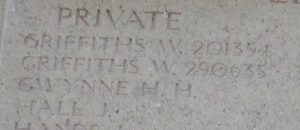
Francis Hughes, Private, 24312, Royal Army Medical Corps. Francis was the son of Francis and Winifred Hughes, of Cemlyn, Dorfil Street, Blaenau Ffestiniog. As well as being a slate worker, he was a member of St. John’s Ambulance at Ffestiniog prior to the war. Francis travelled to Winchester to enlist into the Royal Army Medical Corps following the outbreak of war and embarked for France, joining the 18th Field Ambulance, Royal Army Medical Corps, which was attached to the 6th Division. During 1916 the Division moved to the Somme and fought throughout the Somme offensive. The following year saw the Division at Arras, where it fought at the Battle of Hill 70, and then during the Battle of Cambrai later in the year. In the spring of 1918, the Division was one of those hit by the German Offensive on the Somme, which had been launched on 21 March, and saw heavy fighting before being withdrawn and moved to Flanders to rest. Unfortunately, the following month the Germans launched another offensive, on the Lys Valley, and the Division became caught up in heavy fighting again. Francis was killed in action by shell-fire on 30 April 1918. The 22-year-old is buried in Esquelbecq Military Cemetery, France.
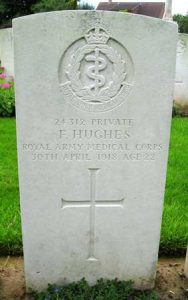
Robert Hughes, Sapper, 121730, Royal Engineers. Robert was the husband of Ellen Hughes, of 143, Manod Road, Blaenau Ffestiniog. He enlisted into the Royal Engineers soon after the outbreak of war and was posted to France on 29 September 1915. After over a year on active service his health broke down, and he was diagnosed as suffering from inflammation of the stomach. Robert was discharged as medically unfit on 24 November 1917, and returned home to Blaenau Ffestiniog where he died on 19 July 1923, too late for commemoration by the CWGC. He left his wife and four children. Robert is not commemorated on the Oakeley Quarries war memorial, probably as he died so long after the war.
Robert Hughes, Private, 9785, Royal Army Medical Corps. Robert was the son of Daniel and Mary Hughes of 2, Barlwyd Avenue, Oakeley Square, Blaenau Ffestiniog. He enlisted at Blaenau Ffestiniog into the Royal Army Medical Corps, and was posted to East Africa with the Royal Army Medical Corps. Robert was posted to the 84th General Hospital, at Dar es Salaam, Tanzania. Robert survived the war, but sadly took ill after the Armistice and died of Influenza at the 84th General Hospital on 26 November 1918, aged 25. He is buried in Dar Es Salaam (Upanga Road) Cemetery, Tanzania.
Thomas Owen Hughes, Lance Corporal, 291545, Royal Welsh Fusiliers. Thomas was the son of Hugh and Sarah Hughes, of Ty Newydd Ffynon, Bethania, Blaenau Ffestiniog. He enlisted at Blaenau Ffestiniog into the 7th Battalion, Royal Welsh Fusiliers on 22 February 1916, and was posted to the 3/7th Battalion, at Park Hall, Oswestry. After completing his training, Thomas embarked for Egypt on 3 July 1916, and upon his arrival joined the 1/7th Battalion, Royal Welsh Fusiliers, which was attached to 158 Brigade, 53rd (Welsh) Division. The Division had been evacuated from Gallipoli in December 1915, moving to Egypt to join the EEF, and helped guard the Suez Canal before taking part in operations to drive the Turks out of the Sinai. The EEF then turned its attention onto driving the Turks out of Palestine, and on 26 March 1917 launched its first offensive against the coastal city of Gaza, which guarded the road to Jerusalem. Initial gains during the day were lost when the assaulting divisions lost touch with each other and communication broke down when a thick fog cloaked the battlefield. A second attempt to force Gaza was launched on 17 April, which also failed, and the EEF suffered a change in leadership, with Sir Edmund Allenby assuming command, before being re-organised, and a third offensive was launched against a wider front from Beersheba to Gaza on 31 October 1917. This time the Turkish defences were breached, and the road to Jerusalem now lay open and the EEF began to advance north. On 6 November 1917, 158 Brigade launched an attack on the Khuweilfeh Heights, and once secured, the EEF continued its advance into the Judean Hills, the 53rd Division capturing Hebron and Bethlehem, before securing the Jerusalem to Jericho road. Allenby finally made his triumphant entry into Jerusalem on 11 December. Thomas was killed in action during a Turkish counter-attack on 28 December 1917, aged 28. He is buried in Jerusalem War Cemetery, Israel.
William Hughes, Private, 49585, South Wales Borderers. William was the son of William Rowland and Ann Hughes, of 91, High Street, Blaenau-Ffestiniog. He enlisted into the South Wales Borderers at Dolgellau, and after completing his training was posted to the 5th Battalion, South Wales Borderers. The battalion was the Pioneer Battalion to the 19th (Western) Division, and had been in France since 16 July 1915, taking part in the Battle of Loos two months later. The Division saw heavy fighting on the Somme the following year, taking part in the fighting at Ovillers-La Boiselle during the first days of the offensive, and then fought through the battles of Poziéres and the Ancre in 1916. In 1917 the Division moved north to Ypres, taking part in the Battle of Messines, before taking part in the main Passchendaele offensive. From 21 March 1918 the division was caught up in the German Spring Offensive, and saw heavy casualties whilst withdrawing past Beugny and Bapaume over the coming days. The weary Division was then transferred to the Messines sector again to rest and rebuild, but was caught up in heavy fighting again when the Germans launched the second phase of their offensive on the Lys Valley from 9 April 1918, and the 19th Division saw terrible fighting at Messines before being forced wo withdraw. After suffering terrible casualties again, the Division moved south to the quieter French sector on the Aisne to rebuild, but was caught up in the third, and final, stage of the German offensive, when the Chemin-des-Dames was attacked on 27 May 1918. On the following day the 5th SWB, in reserve, received orders to ‘Stand-To’ and be ready to move at short notice and later that day moved to Chaumuzy by lorry. At mid-day on 29 May the battalion moved again, to La Neuville-aux-Larris, and on the morning of 30 May moved to Ham before arriving at Chambrecy, near the battle area. An advance party found the front line to be on the Romigny to Chatillon road, and the men took over a section of the line here by 12.30. Soon the front line was hit by the Germans, and after a brief, but fierce, fight, the battalion was forced to withdraw. William was badly wounded during the fight that day, and died that same day, 30 May 1918. The 19-year-old has no known grave and is commemorated on the Soissons Memorial, France.
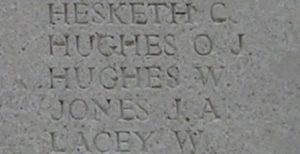
David David Jones, Private, 25252, Royal Welsh Fusiliers. David was the son of David and Catherine Jones, of Hendy, Talywaenydd, Blaenau Ffestiniog. He enlisted at Blaenau Ffestiniog into the 17th Battalion, Royal Welsh Fusiliers on 22 March 1915. The battalion was raised at Llandudno, joining the 43rd (Welsh) Division and trained in North Wales before moving to Winchester in the summer of 1915, where the division became renumbered and the 17th RWF was attached to 115 Brigade, 38th (Welsh) Division. The Division moved to France on 2 December 1915 and moved to the Nursery Sector near Fleurbaix for trench initiation alongside the Guards Division. David was wounded in the leg when the 17th RWF was in the line at Gorre on 26 March and was evacuated via the 130th Field Ambulance to the 32nd Casualty Clearing Station, before being hospitalised at Arques, near St. Omer. On 8 May he re-joined the battalion in the line at Fauquissart. Two days later the Division was relieved and began its move south to the Somme sector, in order to take part in the forthcoming Somme offensive. The Division moved into the battle area by 5 July, and marched past the recently captured village of Mametz, to positions south of its objective, Mametz Wood. The first attack on the wood was launched on a two-battalion front on 7 July, led by the 16th Welsh, and the 17th RWF was in reserve. This initial attack failed, the 16th Welsh suffering heavily due to inadequate artillery support and enfilade fire. The 17th RWF, in support, suffered few casualties, but unfortunately David was among them, being shot in the thigh. He was evacuated via the 96th Field Ambulance to the 2nd Hospital in Abbeville, where he died of his wounds on 4 August 1916, aged 33. David is buried in Abbeville Communal Cemetery, France.
Elias Jones, Private, 44135, South Wales Borderers. Elias was the son of Robert and Elizabeth Jones, of Tynypistyll, Tanygrisiau, Blaenau Ffestiniog. He had worked in Aberfan around the turn of the century until returning home to work at the Oakeley Quarries. Elias married Maggie Thomas in 1902, and the couple resided at 9, New Street, Blaenau Ffestiniog. Elias enlisted at Blaenau Ffestiniog into the Royal Welsh Fusiliers, but after completing his training was posted to the 11th Battalion, South Wales Borderers, which was attached to 115 Brigade, 38th (Welsh) Division. He probably joined the battalion after the Division had been withdrawn from the Somme sector and moved to the Canal Banks sector at Boesinghe. The infantry battalions of the Division then began carrying out the normal pattern of rotation in the trenches, four days in the front, four in support and four in reserve, whilst also working on trench improvement, digging new trenches, and also carrying out regular patrols and trench raids. The Allies were gearing up for one of the most infamous battles of the war, the Third Battle of Ypres, or Passchendaele, and the 38th Division had been tasked with taking the Pilckem Ridge and the ground leading up to the Steenbeek. In the early hours of 31 July 1917, the Division launched its assault from its positions on the Canal, and assaulted the German trenches and pill-boxes facing them. Elias was killed in action during the days fighting. The 41-year-old has no known grave and is commemorated on the Ypres (Menin Gate) Memorial, Belgium.
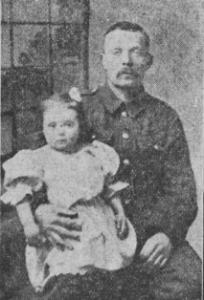
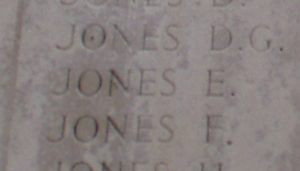
John Thomas Jones, Private, 5352, Royal Welsh Fusiliers. John was the son of Griffith and Jane Jones, of 15, Cwmnorthin Road, Tanygrisiau, Blaenau Ffestiniog. He enlisted at Blaenau Ffestiniog into the Royal Welsh Fusiliers soon after the outbreak of war, and landed in France on 11 January 1915, joining the 1st Battalion, Royal Welsh Fusiliers, which was attached to 22 Brigade, 7th Division. He joined the battalion in the line near Le Touquet. During March 1915 the Division took part in the Battle of Neuve Chapelle. During May the Division fought at the Battle of Aubers Ridge, and then fought at Festubert. The Division then took part in the Battle of Loos from 25 September. The Division took part in the initial assault north of the Vermelles-Hulluch road, facing the Quarries and a series of strong-points. Suffering badly from British cloud gas, which was not moved sufficiently by the gentle breeze, and badly cut up by German machine gun fire and artillery, the Division nonetheless seized the Quarries and only failed to penetrate the third German line due to the relative weakness of the numbers of men that got through. The 1st RWF had suffered severe casualties, with two officers and 43 men killed, 14 officers and 246 men wounded, with 135 more missing. John was among the wounded. He was evacuated to the No 2 London Casualty Clearing Station at Merville, where he died of his wounds on 30 September 1915, aged 36. John is buried in Merville Communal Cemetery, France.
John William Jones, Private, 25215, Royal Welsh Fusiliers. John was the son of William and Margaret Jones, of Dolbryn, Glanypwll Road, Blaenau Ffestiniog. He enlisted at Blaenau Ffestiniog into the 17th Battalion, Royal Welsh Fusiliers on 26 February 1915. The battalion was raised at Llandudno, joining the 43rd (Welsh) Division and trained in North Wales before moving to Winchester in the summer of 1915, where the division became renumbered and the 17th RWF was attached to 115 Brigade, 38th (Welsh) Division. The Division moved to France on 2 December 1915 and moved to the Nursery Sector near Fleurbaix for trench initiation alongside the Guards Division. The Division then held a sector of the line near Cuinchy before marching south to the Somme sector in June 1916 to take part in the assault on Mametz Wood. The first attack on the wood was launched on a two-battalion front on 7 July, but failed, and the Divisional Commander, Sir Ivor Philipps, was replaced before the Division attacked again on a two Brigade front on 10 July 1916. John was badly wounded, being shot in the back, during the fighting in the wood at some time between 10 and 12 July. He was recovered from the wood and evacuated to the 38th Casualty Clearing Station at Heilly, where he died of his wounds on 15 July 1916, aged 32. John is buried in Heilly Station Cemetery, Mericourt-L’Abbe, France. His brothers, Thomas William Jones and William Ellis Jones, also fell.
Robert Gwynedd Jones, Private, 57571, Welsh Regiment. Robert was son of John David Jones and Elizabeth Jones, of Mount Pleasant, Talywaenydd, Blaenau Ffestiniog. He enlisted at Blaenau Ffestiniog into the 53rd (Young Soldiers) Battalion, Welsh Regiment on 28 November 1917 and was posted to Kinmel Park for training. On 31 March 1918 he embarked for France and joined the Infantry Base Depot at Étaples. On 21 June he was posted to the 24th Battalion, Welsh Regiment, which was in Flanders attached to 231 Brigade, 74th (Yeomanry) Division. The battalion had been formed in Egypt on 2 February 1917, by the merger of the 1/1st Glamorgan Yeomanry with the 1/1st Pembroke Yeomanry, and had taken part in the Palestinian campaign. The Division had been transferred to the Western Front in April 1918, following heavy losses during the German Spring Offensive, and had arrived at Marseilles during May 1918, before taking over a sector of the line in the St. Floris sector, in Flanders. On 26 July 1918 the men of the 24th Welsh witnessed at first hand the aerial fight and crash at Lestrem which led to the death of the famed air-fighter, Major Edward ‘Mick’ Mannock, VC, DSO, MC. At the end of August, the 74th Division was moved to the Somme, and relieved the 58th Division round Bouchavesnes, three miles north of Péronne. The Division then took part in the great offensive, seeing heavy fighting around Nurlu and advancing towards Villers Faucon, which the 24th Welsh took on 7 September. The Allies were now within striking distance of the Hindenburg Line, and on 18 September the 74th Division launched an assault on the front from Templeux to Ronssart. The 24th Welsh suffered heavy casualties during the fighting for Gillemont Farm that day. John was wounded during the assault on the fam and was evacuated to the 6th General Hospital at Rouen, where he died of his wounds on 21 September 1918, aged 18. He is buried in St. Sever Cemetery Extension, Rouen, France.
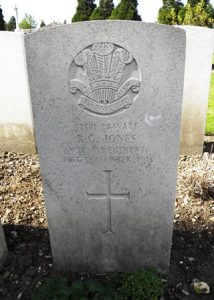
Robert Owen Jones, Private, 74115, Sherwood Foresters (Notts and Derby Regiment). Robert was born in Trevor, Caernarvonshire. He worked as a cotton warehouseman in Liverpool prior to the war and married Annie Mary Hughes there on 31 July 1915. The couple then lived at 49, Vandyke Street, Liverpool. Robert enlisted into the 12th Battalion, Royal Welsh Fusiliers at Liverpool on 22 November 1915 and was placed on the army reserve. The couple then moved to 7, Brondwyryd, Blaenau Ffestiniog, where Robert had gained worked at the Oakeley Quarries, and their son, Owen Trevor Jones, was born there on 11 June 1916. Robert was mobilised soon afterwards and embarked for France on 4 January 1917. On 25 January he was posted to the 177th Tunnelling Company, Royal Engineers, in the Railway Wood Sector near Hooge, and then a month later joined the 256th Tunnelling Company, on the Flanders coast near Nieuwpoort, which was working on shelters and wells for Operation Hush, a planned offensive along the coast. By September it had become obvious that Operation Hush would be cancelled, as the Third Battle of Ypres had stalled in the Flanders mud, so Robert was posted back to the Infantry Base Depot at Rouen, before being granted leave on 31 December 1917 and returning home. By 14 January 1918 Robert was back in France and in April was posted to the 10th Battalion, Sherwood Foresters (Notts and Derby Regiment), which was attached to 51 Brigade, 17th (Northern) Division, which was at Mesnil rebuilding following heavy fighting during the German Spring Offensive of 21 March. After a period out of the line to rest and rebuild, the Division worked in conjunction with the 38th (Welsh) Division throughout the summer. On 12 August the Division moved slightly south to the Somme valley, near Vaux and took over the line there. On 15 August the 10th Sherwood Foresters were in the line at Vaux, when the Germans bombarded their positions with gas shell. Robert was among a large number of casualties suffered by the battalion during the bombardment, and was evacuated to the 9th General Hospital, Rouen, where he died of gas poisoning on 21 August 1918, aged 24. He is buried in St. Sever Cemetery Extension, Rouen, France.
Thomas William Jones, Private, 70149, Royal Welsh Fusiliers. Thomas was the son of William and Margaret Jones of Dolbryn House, Glan-y-Pwll Road, Blaenau Ffestiniog. He married Mary Edwards in 1911 and the couple lived at 8, Penygroes, Bethania, Blaenau Ffestiniog. Thomas enlisted at Blaenau Ffestiniog into the 17th Battalion, Royal Welsh Fusiliers early in 1915. The battalion was raised at Llandudno, joining the 43rd (Welsh) Division and trained in North Wales before moving to Winchester in the summer of 1915, where the division became renumbered and the 17th RWF was attached to 115 Brigade, 38th (Welsh) Division. The Division moved to France on 2 December 1915 and moved to the Nursery Sector near Fleurbaix for trench initiation alongside the Guards Division. The Division then held a sector of the line near Cuinchy before marching south to the Somme sector in June 1916 to take part in the assault on Mametz Wood. The first attack on the wood was launched on a two-battalion front on 7 July, but failed, and the Divisional Commander, Sir Ivor Philipps, was replaced before the Division attacked again on a two Brigade front on 10 July 1916. Thomas was wounded at some time in 1916, possibly at Mametz Wood, and was sent back to Britain for treatment. After recovering, he was posted back to France, joining the 10th Battalion, Royal Welsh Fusiliers, which was attached to 76 Brigade, 3rd Division. In May 1917 the Division was at Arras, and fought at the First and Second Battles of the Scarpe, then at the Battle of Arleux and the Third Battle of the Scarpe, where it captured Roeux. The Division then spent several months in the trenches near Louverval until leaving the area on 17 September and entraining for Godewaersvelde, and on 25 September arrived in the city of Ypres. The 10th RWF then marched out of the Menin Gate over the Hannebeek, taking up positions in the front line by midnight. At 03.40 on the following morning, 26 September 1917, the British artillery opened up, and soon afterwards the 3rd Division went over the top, crossing the Steenbeek before assaulting the German lines near the Zonnebeke. Thomas was killed in action during the terrible fighting that day. He has no known grave and is commemorated on the Tyne Cot Memorial, Belgium. His brothers, John William Jones and William Ellis Jones, also fell.
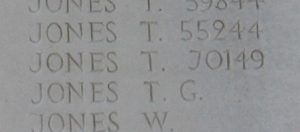
William Ellis Jones, Lance Corporal, 25214, Royal Welsh Fusiliers. William was the son of William and Margaret Jones of Dolbryn House, Glan-y-Pwll Road, Blaenau Ffestiniog. He enlisted into the 17th Battalion, Royal Welsh Fusiliers at Blaenau Ffestiniog on 26 February 1915. The battalion was raised at Llandudno, joining the 43rd (Welsh) Division and trained in North Wales before moving to Winchester in the summer of 1915, where the battalion joined the re-numbered 115 Brigade, 38th (Welsh) Division. The Division moved to France on 2 December 1915 and moved to the Nursery Sector near Fleurbaix for trench initiation alongside the Guards Division. The Division then held a sector of the line near Cuinchy before marching south to the Somme sector in June 1916 to take part in the assault on Mametz Wood. The first attack on the wood was launched on a two-battalion front on 7 July, but failed, and the Divisional Commander, Sir Ivor Philipps, was replaced before the Division attacked again on a two Brigade front on 10 July 1916. After two days of ferocious hand-to-hand fighting, the wood was cleared up to its northern edge, before the battered Division was relieved. It then took over a section of the front at Hébuterne before moving to the Ypres Salient, and taking over the Canal Bank sector at Boesinghe. The infantry battalions of the Division then began carrying out the normal pattern of rotation in the trenches, four days in the front, four in support and four in reserve, whilst also working on trench improvement, digging new trenches, and also carrying out regular patrols and trench raids. On 13 February 1917 William was in a working party just behind the line at Bleuet Farm, Boesinghe when he was killed by shellfire. The 39-year-old is buried in Ferme Olivier Cemetery, Ieper, Belgium. His brothers, John William Jones and Thomas William Jones, also fell.
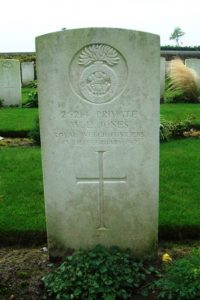
William Griffith Jones, Private, 128152, Machine Gun Corps. William was the son of Griffith Evan and Margaret Jones, of Plas-y-Bryn, Blaenau Ffestiniog. He married Maggie Ann Jones in 1912 and the couple lived at Bryn Tegid, Cwm Bonydd Road, Blaenau Ffestiniog. William was a sub-manager at Maen Offeren Quarry, so did not enlist until 1917, when he joined the Royal Welsh Fusiliers. After completing his training, he was posted to France, joining the 39th Battalion, Machine Gun Corps. The battalion had formed on 14 March 1918, by amalgamating the former three brigade machine-gun companies of the 39th Division, and became the Divisions Machine Gun Company. The Company refitted at Haut Allaines and re-joined the Division in the line near Saulcourt on 21 March, with its Companies taking over positions at Longavesnes, the Saulcourt to Tincourt Switch Line and at Gurlu Wood. The Germans had launched their Spring offensive on the line running from Croisilles to La Fère that morning, so the Division was sat in defensive positions, and waited for the inevitable onslaught. First contact with the Germans was made that afternoon, and over the coming days fighting raged as the line was pushed back. William was killed in action during heavy fighting near Clery on 23 March 1918. The 35-year-old has no known grave and is commemorated on the Pozieres Memorial, France. His son, Griffith Selyf Jones, was lost at sea in WW2.
Benjamin Lewis, Private, 55470, Northumberland Fusiliers. Benjamin was the son of David and Margaret Lewis, of Blaenau Ffestiniog. He married Annie Jane Hughes in 1917 and the couple resided at Glandwr, Tanygrisiau, Blaenau Ffestiniog. He enlisted into the army at Wrexham and initially joined the Cheshire Regiment. Upon completing his training, Benjamin spent a short while with the Labour Corps, before being posted to the 10th Battalion, Northumberland Fusiliers. The battalion had been in France with 68 Brigade, 23rd Division since August 1915 and moved with the Division to Italy in November 1917, to aid the Italian army, which was defending its frontier with Austria. On 4 December the Division took over a section of front line on the Montello, relieving the 70th Italian Division, and then fought at the Second Battle of the Piave River and then the Battle of Vittorio Veneto. Benjamin must have been wounded during the early stage of the latter, which began on 24 October, as he died of wounds on 28 October 1918. The 28-year-old is buried in Giavera British Cemetery, Arcade, Italy.
Arthur Vaughan Owen, Private, 48324, Royal Army Medical Corps. Arthur was the son of John and Emily Owen, of Llys Aled, Cae Clyd Road, Blaenau Ffestiniog. He was a member of St. John’s Ambulance Brigade at Blaenau Ffestiniog prior to the war, and travelled to Cardiff to enlist into the 130th (St. John’s) Field Ambulance, Royal Army Medical Corps soon after the outbreak of war. The Division trained at various locations in North Wales before moving to Morn Hill Camp, Winchester in the summer of 1915, to train as a complete Division, preparing for a move to the Western Front. Sadly, Arthur became ill whilst in Winchester, and died of meningitis there on 27 September 1915, aged 20. His remains were brought home for burial in Blaenau Ffestiniog (Bethesda) Cemetery.
Evan Owen, Private, 290637, Royal Welsh Fusiliers. Evan was the son of Evan and Annie Owen, of Tynllwyn, Tanygrisiau, Blaenau Ffestiniog. He enlisted into the 7th Battalion, Royal Welsh Fusiliers at Blaenau Ffestiniog on 19 September 1914. The battalion was a Territorial unit, which mobilised for war at Newtown in August 1914, as part of North Wales Brigade, Welsh Division and moved to Conway until the end of the month, before moving to Northampton. In December the Division moved to Cambridge and then in May 1915 to Bedford, where the Division was numbered and the formation became 158 Brigade, 53rd (Welsh) Division. On 19 July 1915 the entire Division sailed from Devonport for Imbros and on 9 August 1915 landed at Suvla Bay. The Division took part in heavy fighting over the coming days, then as winter drew in, were subject to terrible conditions, with snow storms and rain so hard at one time that even the bodies of the dead were washed from their graves into the trenches. Evan was evacuated aboard the Hospital Ship Sudan just prior to the Division being relieved, as he had fallen ill. By the time he had re-joined the battalion, from Hospital in Malta, the Division was on the Suez Canal defences, as part of the EEF, taking part in operations to drive the Turks out of the Sinai. The EEF then turned its attention onto driving the Turks out of Palestine, and on 26 March 1917 launched its first offensive against the coastal city of Gaza, which guarded the road to Jerusalem. Initial gains during the day were lost when the assaulting divisions lost touch with each other and communication broke down when a thick fog cloaked the battlefield. Evan was posted as missing, believed killed in action, here on 26 March 1917. The body of the 29-year-old was never identified, so he is commemorated on the Jerusalem Memorial, Israel.
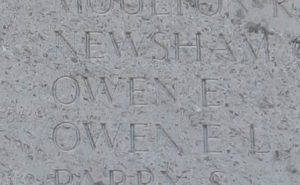
Gwalchmai Owen, Private, 25242, Royal Welsh Fusiliers. Gwalchmai was the son of Owen and Margaret Owen, of Blaenau Ffestiniog. He married Sarah Ellen Hughes at Moriah Chapel, Dolwyddelan on 21 May 1902 and the couple set up home at 56, High Street, Blaenau Ffestiniog, where their four children were born. Gwalchmai enlisted into the 17th Battalion, Royal Welsh Fusiliers at Blaenau Ffestiniog on 19 March 1915. The battalion was raised at Llandudno, joining the 43rd (Welsh) Division and trained in North Wales before moving to Winchester in the summer of 1915, where the battalion joined the re-numbered 115 Brigade, 38th (Welsh) Division. The Division moved to France on 2 December 1915 and moved to the Nursery Sector near Fleurbaix for trench initiation alongside the Guards Division. The Division then held a sector of the line near Cuinchy before marching south to the Somme sector in June 1916 to take part in the assault on Mametz Wood. The first attack on the wood was launched on a two-battalion front on 7 July, but failed, and the Divisional Commander, Sir Ivor Philipps, was replaced before the Division attacked again on a two Brigade front on 10 July. Gwalchmai was killed in action during the heavy fighting for the wood on 10 July 1916. The 42-year-old has no known grave and is commemorated on the Thiepval Memorial, France.
William Pritchard Parry, Private, 40315, Royal Welsh Fusiliers. William was the son of William and Ann Parry, of Salem Cottage, Rhiwbryfdir, Blaenau Ffestiniog. He enlisted at Blaenau Ffestiniog into the Royal Welsh Fusiliers, and was posted to France after completing his training, joining the 10th Battalion, Royal Welsh Fusiliers, which was attached to 76 Brigade, 3rd Division. He most probably joined the battalion in the Ypres Salient, following a period of intense fighting during the Actions of the Bluff, and at the St Eloi Craters. On 26 May the Division was relieved and moved into V Corps Reserve at Thieushouk, then at the beginning of June moved to Meteren, where news was received of the tragic death of Lord Kitchener. By 13 June the Division was at Eperlecques, where training was begun in earnest in preparation for a move south to the Somme. On 1 July the Division entrained for ‘an unknown destination’, and arrived at Doullens the following day. The Battle of the Somme had opened the previous day, and the 3rd Division was in the sector, ready to play its part in the offensive, and over the coming days began moving forward into the battle area. By 13 July the Division was in position, taking over captured German trenches in Montauban Alley and on the following day took part in its first offensive on the Somme, advancing the line to Caterpillar Valley, in front of Longueval. The 10th RWF then spent the coming days working in improving trenches and communications, before the next phase of their advance, which was launched on 19 July, after receiving orders to assault Delville Wood. William was killed in action in Delville Wood on the following day, 20 July 1916, during fierce fighting which saw two men of his battalion awarded the Victoria Cross. The 19-year-old has no known grave, so is commemorated on the Thiepval Memorial, France.
Richard Thomas, Private, 24651, Royal Welsh Fusiliers. Richard was the son of Richard and Ann Thomas, of 12, Lord Street, Blaenau Ffestiniog. He married Laura Williams, at Porthmadog, on 21 March 1905 and the couple lived at 4, Glan Yr Avon Terrace, Tanygrisiau, Blaenau Ffestiniog. Richard enlisted into the 17th Battalion, Royal Welsh Fusiliers on 22 March 1915. He joined the battalion at Llandudno, where it was training with the 43rd (Welsh) Division. The Division was re-numbered to the 38th (Welsh) Division in April 1915, just prior to the Divisions move to Winchester for further training. There were many surplus men with the battalions in the 38th (Welsh) Division, and Richard was among a number of men posted to the 20th (Reserve) Battalion, Royal Welsh Fusiliers in September, moving back to North Wales to join the battalion at Kinmel Park. A year later he was posted to the 63rd Training Reserve Battalion, but by now he was suffering with his health. Richard was discharged as medically unfit on 21 September 1916 and returned home to his wife and three children, but sadly he died of tuberculosis on 8 May 1917, aged 34. Richard is not commemorated as an official casualty of war by the CWGC. His brother, Hugh Thomas, died on 1 May 1918 as a result of his wartime service.
William Henry Thomas, Private, 53890, Northumberland Fusiliers. William was the son of William and Gaynor Thomas, of 21 Glynllifon Street Blaenau Ffestiniog. He married Elizabeth Ellen Williams in 1911 and the couple lived at Oakeley Terrace, Talywanydd. William enlisted at Blaenau Ffestiniog into the 16th Battalion, Royal Welsh Fusiliers soon after the outbreak of war. It is not currently known if he served on the Western Front with the battalion, which was attached to 113 Brigade, 38th (Welsh) Division, but he was later transferred to the 2nd (Garrison) Battalion, Northumberland Fusiliers, which was in Mesopotamia. William survived the war and returned home to Blaenau Ffestiniog, but died of influenza on 6 March 1919, aged 32. He is buried in Blaenau Ffestiniog (Bethesda) Cemetery. His widow Ellen Williams died of influenza two weeks later.